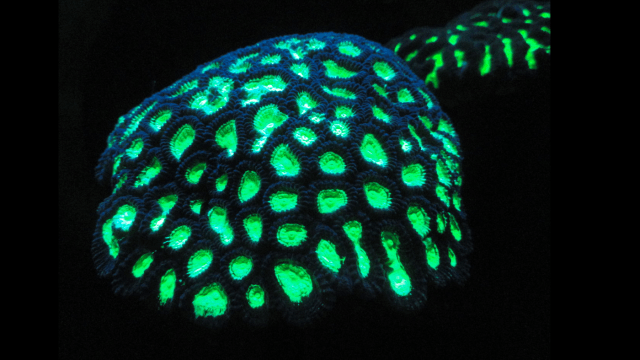A lot of creatures glow in the ocean’s depths, where sunlight is slim to nil. But while most of these abyssal lightbulbs use their neon powers to hunt or avoid being hunted, deepwater corals may have beat everything else down there in terms of evolutionary creativity. New research indicates these corals glow in order to eat the meagre sunlight, turning their tissues into grow chambers that nourish tiny plants in a beam of artificial luminosity.
Image: Wikimedia
We tend to picture corals awash in sunlight in the shallow tropics, but certain species also thrive in the “mesophotic zone” where light is perpetually dim. Found 30 to 150m beneath the ocean’s surface, these “twilight” corals may serve as important repositories of fish and marine invertebrates that sustain shallow reef ecosystems, according to NOAA.
Scientists still have many basic questions about mesophotic corals — including how they manage to eke by on such limited sunlight. Like their shallow-water counterparts, many mesophotic corals rely on symbiotic algae as their main source of nutrition. And those algae require sunlight to do photosynthesis.
Previous research has shown that corals sometimes acclimate to low light environments by boosting the number of photosynthetic algae in their tissue, which is a bit like trying to run your house off solar power in cloudy Seattle by slapping more and more photovoltaic panels on the roof. But at depths where light is always scarce, boosting the number of solar panels can have drawbacks. As more algae pack together, darkening the coral’s outer tissue layers, they prevent sunlight from penetrating deeper inside the organism.
To avoid this problem, and maximise the amount of sunshine available throughout their bodies for deep sea algae farming, mesophotic corals take advantage of photoconvertible red fluorescent proteins (pcRFPs), molecules that absorb photons of light at certain wavelengths, and re-emit its energy in other parts of the spectrum. In shallow, well-illuminated waters, corals use similar fluorescent proteins to absorb harmful ultraviolet rays, and “downshift” the light to safer colours. In deepwater corals, pcRFPs take readily-available blue light and downshift it to red and orange hues, which spread more easily throughout the coral’s tissue, according to research published last week in the Proceedings of the Royal Society B.
This process also causes the coral’s tissue to fluoresce, creating the beautiful, glowing displays deepwater corals are famous for.
Through aquarium experiments, the researchers showed that red colour morphs — corals that express more pcRFPs — outperformed corals with less pigment in the dim, blue light environments characteristic of the mesophotic zone. This finding corroborated the results of a field surveys in the Red Sea, which revealed more pcRFP-toting corals at greater depths. Finally, by exposing coral tissues to different light environments in the lab, the researchers showed how the optical properties of pcRFPs could be “tuned” to the ambient light field, with deepwater lighting conditions promoting the conversion of light from blue to orange.
“These differences in photoconversion efficiency among pcRFPs could help different species to exploit distinct light niches found along depth gradients,” the authors write.
More research, of course, is needed to fully understand the range of adaptations corals use to thrive in the mesophotic zone — and even deeper parts of the water column that don’t see any sunlight at all. But at least one outside expert, coral biologist Charles Manzel, thought the new research was “significant” for identifying a novel adaptation corals use to survive in light-limited environments. “The work is part of a growing body of research that goes beyond speculation (of which there has been far too much) to demonstrating method and efficacy,” he told Gizmodo.
Clearly, even as as we humans continue to cause serious problems for corals around the world, these fascinating organisms still have many secrets to give up.
